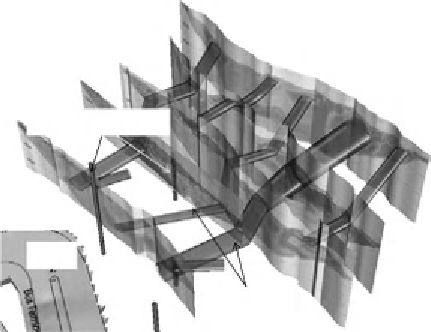Geology Reference
In-Depth Information
velocity between the overlying and underlying strata and some knowl-
edge of the geological pro
le, preferably from boreholes. Otherwise,
results will be ambiguous. Where weak (low velocity) strata underlie
stronger materials, these may not be identi
ed by seismic survey. Wave
velocity (compressive and shear) can be interpreted directly in terms of
rock mass quality, deformation modulus and ease of excavation, as
reviewed comprehensively by Simons et al. (2001). Seismic re
ection is
a key technique in offshore investigations.
4.5.2 Resistivity
Resistivity is another cheap and rapid method that can prove very
effective, particularly in identifying groundwater (low resistance) and
voids (high resistance). The technique has been used successfully in the
investigation of landslide pro
les, in particular for identifying water-
bearing strata at depth.
Figure 4.21
shows the results of a resistivity
survey in Hong Kong to identify underground stream channels as
zones of high resistance (voids), which it did extremely well (Hencher
et al., 2008).
4.5.3 Other techniques
There are a host of other techniques reported in the literature, with
various success rates. Ground-based radar can be useful for
finding
shallow hidden pipes, etc. Other techniques such as magnetic and
micro-gravity rely on particular physical properties of the rock or
feature being searched for. Both have been used for locating old mine
Borehole locations
Road
Underground streams
Figure 4.21 Digital image interpretation of resistivity surveys across hillside above Yee King Road,
Hong Kong. Tubular features of low resistivity are interpreted as underground streams (Hencher
et al., 2008).

